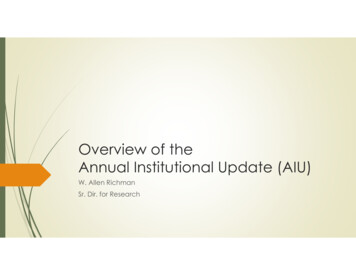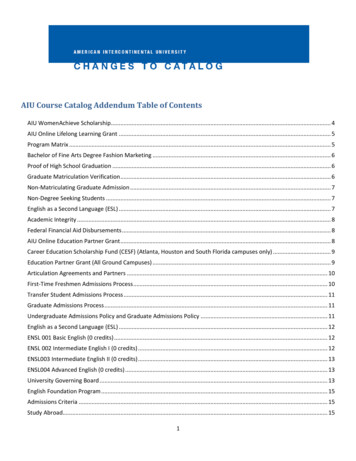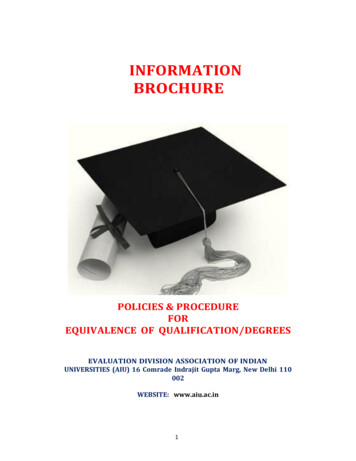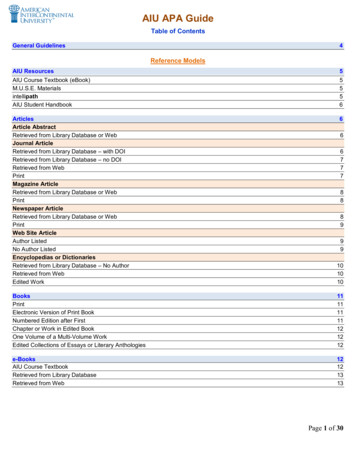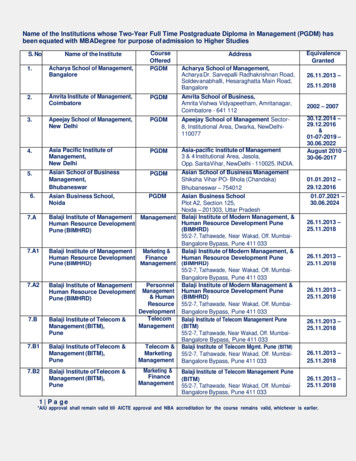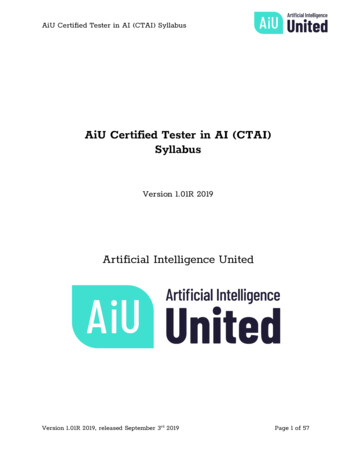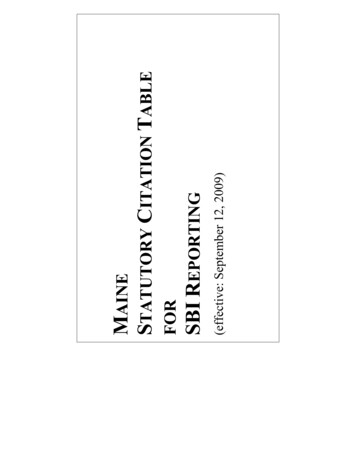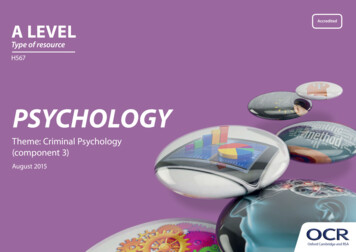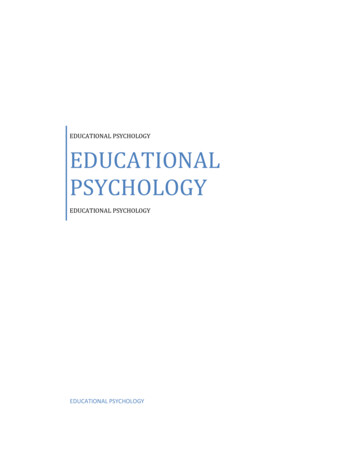
Transcription
EDUCATIONAL PSYCHOLOGYEDUCATIONALPSYCHOLOGYEDUCATIONAL PSYCHOLOGYEDUCATIONAL PSYCHOLOGY
Session 6Bloom's taxonomyBloom's wheel, according to the Bloom's verbs and matching assessment types. The verbs areintended to be feasible and measurable.Bloom's taxonomy is a way of distinguishing the fundamental questions within the educationsystem. It is named after Benjamin Bloom, who chaired the committee of educators that devisedthe taxonomy. He also edited the first volume of the standard text, Taxonomy of EducationalObjectives: The Classification of Educational Goals.[1]Bloom's taxonomy refers to a classification of the different objectives that educators set forstudents (learning objectives). It divides educational objectives into three "domains": cognitive,affective, and psychomotor (sometimes loosely described as "knowing/head", "feeling/heart" and"doing/hands" respectively). Within the domains, learning at the higher levels is dependent onhaving attained prerequisite knowledge and skills at lower levels.[2] A goal of Bloom's taxonomyis to motivate educators to focus on all three domains, creating a more holistic form ofeducation.[1]Bloom's taxonomy is considered to be a foundational and essential element within the educationcommunity.[3] A mythology has grown around the taxonomy, possibly due to many peoplelearning about the taxonomy through second hand information. Bloom himself considered theHandbook "one of the most widely cited yet least read books in American education".[4][
HistoryAlthough named after Bloom, the publication of Taxonomy of Educational Objectives followed aseries of conferences from 1949 to 1953, which were designed to improve communicationbetween educators on the design of curricula and examinations.[5]The first volume of the taxonomy, "Handbook I: Cognitive" (Bloom et al. 1956) was publishedin 1956. "Handbook II: Affective" (Krathwohl, Bloom & Masia 1965) followed in 1965. A thirdvolume, for the psychomotor domain, was planned, but never published. Other educators createdtheir own taxonomies within this domain, including Simpson (1966), Harrow (1972) and Dave(1975).[6][7] A revised version of the taxonomy for the cognitive domain was created in 2000.[8][7]CognitiveCategories in the cognitive domain of the revised Bloom's taxonomy (Anderson et al. 2000)Skills in the cognitive domain revolve around knowledge, comprehension, and critical thinkingon a particular topic. Traditional education tends to emphasize the skills in this domain,particularly the lower-order objectives.There are six levels in the taxonomy, moving through the lowest order processes to the highest:KnowledgeExhibit memory of learned materials by recalling facts, terms, basic concepts and answers Knowledge of specifics - terminology, specific factsKnowledge of ways and means of dealing with specifics - conventions, trends andsequences, classifications and categories, criteria, methodologyKnowledge of the universals and abstractions in a field - principles and generalizations,theories and structuresQuestions like: What are the health benefits of eating apples?
ComprehensionDemonstrate understanding of facts and ideas by organizing, comparing, translating, interpreting,giving descriptions, and stating the main ideas TranslationInterpretationExtrapolationQuestions like: Compare the health benefits of eating apples vs. oranges.ApplicationUsing acquired knowledge. Solve problems in new situations by applying acquired knowledge,facts, techniques and rules in a different wayQuestions like: Which kinds of apples are best for baking a pie, and why?AnalysisExamine and break information into parts by identifying motives or causes. Make inferences andfind evidence to support generalizations Analysis of elementsAnalysis of relationshipsAnalysis of organizational principlesQuestions like: List four ways of serving foods made with apples and explain which ones havethe highest health benefits. Provide references to support your statements.EvaluationPresent and defend opinions by making judgments about information, validity of ideas or qualityof work based on a set of criteria Judgments in terms of internal evidenceJudgments in terms of external criteriaQuestions like: Do you feel that serving apple pie for an after school snack for children ishealthy?SynthesisCompile information together in a different way by combining elements in a new pattern orproposing alternative solutions
Production of a unique communicationProduction of a plan, or proposed set of operationsDerivation of a set of abstract relationsQuestions like: Convert an "unhealthy" recipe for apple pie to a "healthy" recipe by replacingyour choice of ingredients. Explain the health benefits of using the ingredients you chose vs. theoriginal ones.AffectiveSkills in the affective domain describe the way people react emotionally and their ability to feelother living things' pain or joy. Affective objectives typically target the awareness and growth inattitudes, emotion, and feelings.There are five levels in the affective domain moving through the lowest order processes to thehighest:ReceivingThe lowest level; the student passively pays attention. Without this level no learning can occur.Receiving is about the student's memory and recognition as well.RespondingThe student actively participates in the learning process, not only attends to a stimulus; thestudent also reacts in some way.ValuingThe student attaches a value to an object, phenomenon, or piece of information. The studentassociates a value or some values to the knowledge they acquired.OrganizingThe student can put together different values, information, and ideas and accommodate themwithin his/her own schema; comparing, relating and elaborating on what has been learned.CharacterizingThe student holds a particular value or belief that now exerts influence on his/her behavior sothat it becomes a characteristic.Psychomotor
Skills in the psychomotor domain describe the ability to physically manipulate a tool orinstrument like a hand or a hammer. Psychomotor objectives usually focus on change and/ordevelopment in behavior and/or skills.Bloom and his colleagues never created subcategories for skills in the psychomotor domain, butsince then other educators have created their own psychomotor taxonomies.[6] Simpson (1972)proposed the following levels:PerceptionThe ability to use sensory cues to guide motor activity. This ranges from sensory stimulation,through cue selection, to translation. Examples: Detects non-verbal communication cues.Estimate where a ball will land after it is thrown and then moving to the correct location to catchthe ball. Adjusts heat of stove to correct temperature by smell and taste of food. Adjusts theheight of the forks on a forklift by comparing where the forks are in relation to the pallet. KeyWords: chooses, describes, detects, differentiates, distinguishes, identifies, isolates, relates,selects.SetReadiness to act. It includes mental, physical, and emotional sets. These three sets aredispositions that predetermine a person's response to different situations (sometimes calledmindsets). Examples: Knows and acts upon a sequence of steps in a manufacturing process.Recognize one's abilities and limitations. Shows desire to learn a new process (motivation).NOTE: This subdivision of Psychomotor is closely related with the “Responding to phenomena”subdivision of the Affective domain. Key Words: begins, displays, explains, moves, proceeds,reacts, shows, states, volunteers.Guided responseThe early stages in learning a complex skill that includes imitation and trial and error. Adequacyof performance is achieved by practicing. Examples: Performs a mathematical equation asdemonstrated. Follows instructions to build a model. Responds to hand-signals of instructorwhile learning to operate a forklift. Key Words: copies, traces, follows, react, reproduce,responds.MechanismThis is the intermediate stage in learning a complex skill. Learned responses have becomehabitual and the movements can be performed with some confidence and proficiency. Examples:Use a personal computer. Repair a leaking tap. Drive a car. Key Words: assembles, calibrates,constructs, dismantles, displays, fastens, fixes, grinds, heats, manipulates, measures, mends,mixes, organizes, sketches.Complex overt response[edit]
The skillful performance of motor acts that involve complex movement patterns. Proficiency isindicated by a quick, accurate, and highly coordinated performance, requiring a minimum ofenergy. This category includes performing without hesitation, and automatic performance. Forexample, players will often utter sounds of satisfaction or expletives as soon as they hit a tennisball or throw a football, because they can tell by the feel of the act what the result will produce.Examples: Maneuvers a car into a tight parallel parking spot. Operates a computer quickly andaccurately. Displays competence while playing the piano. Key Words: assembles, builds,calibrates, constructs, dismantles, displays, fastens, fixes, grinds, heats, manipulates, measures,mends, mixes, organizes, sketches. NOTE: The Key Words are the same as Mechanism, but willhave adverbs or adjectives that indicate that the performance is quicker, better, more accurate,etc.AdaptationSkills are well developed and the individual can modify movement patterns to fit specialrequirements. Examples: Responds effectively to unexpected experiences. Modifies instructionto meet the needs of the learners. Perform a task with a machine that it was not originallyintended to do (machine is not damaged and there is no danger in performing the new task). KeyWords: adapts, alters, changes, rearranges, reorganizes, revises, varies.OriginationCreating new movement patterns to fit a particular situation or specific problem. Learningoutcomes emphasize creativity based upon highly developed skills. Examples: Constructs a newtheory. Develops a new and comprehensive training programming. Creates a new gymnasticroutine. Key Words: arranges, builds, combines, composes, constructs, creates, designs, initiate,makes, originates.Definition of knowledgeIn the appendix to Handbook I, there is a definition of knowledge which serves as the apex for analternative, summary classification of the educational goals. This is significant as the taxonomyhas been called upon significantly in other fields such as knowledge management, potentially outof context.Knowledge, as defined here, involves the recall of specifics and universals, the recall of methodsand processes, or the recall of a pattern, structure, or setting.— [9]The taxonomy is set out: 1.00 Knowledgeo 1.10 Knowledge of Specificso 1.11 Knowledge of Terminologyo 1.12 Knowledge of Specific Facts
ooooooooo1.20 Knowledge of Ways and Means of Dealing with Specifics1.21 Knowledge of Conventions1.22 Knowledge of Trends and Sequences1.23 Knowledge of Classifications and Categories1.24 Knowledge of Criteria1.25 Knowledge of Methodology1.30 Knowledge of The Universals and Abstractions in a Field1.31 Knowledge of Principles and Generalizations1.32 Knowledge of Theories and StructuresCriticism of the taxonomyAs Morshead (1965) pointed out on the publication of the second volume, the classification wasnot a properly constructed taxonomy, as it lacked a systemic rationale of construction.This was subsequently acknowledged in the discussion of the original taxonomy in its 2000revision,[8] and the taxonomy reestablished on more systematic lines. It is generally consideredthat the role the taxonomy played in systematising a field was more important than any perceivedlack of rigour in its construction.Some critiques of the taxonomy's cognitive domain admit the existence of these six categories,but question the existence of a sequential, hierarchical link.[10] Often, educators view thetaxonomy as a hierarchy and dismiss the lowest levels as unworthy of teaching[citation needed]. Thelearning of the lower levels enables the building of skills in the higher levels of the taxonomy.This scaffolding process is an application of Vygotskian constructivism.[11] Also the revisededition of Bloom's taxonomy has moved Synthesis higher in the order than Evaluation. Someconsider the three lowest levels as hierarchically ordered, but the three higher levels as parallel.[8]Others say that it is sometimes better to move to Application before introducing concepts[citationneeded], the idea being to create a learning environment where the real world context comes first andthe theory second to promote the student's grasp of the phenomenon, concept or event. Thisthinking would seem to relate to the method of problem-based learning.Furthermore, the distinction between the categories can be seen[according to whom?] as artificial since anygiven cognitive task may entail a number of processes. It could even be argued that any attemptto nicely categorize cognitive processes into clean, cut-and-dried classifications undermines theholistic, highly connective and interrelated nature of cognition.[12] This is a criticism that can bedirected at taxonomies of mental processes in general.AlternativesImplications
Bloom’s taxonomy serves as the backbone of many teaching philosophies, in particular thosethat lean more towards skills rather than content.[8][7] These educators would view content as avessel for teaching skills. The emphasis on higher-order thinking inherent in such philosophies isbased on the top levels of the taxonomy including analysis, evaluation, synthesis and creation.Bloom’s taxonomy can be used as a teaching tool to help balance assessment and evaluativequestions in class, assignments and texts to ensure all orders of thinking are exercised instudent’s learning.Connections to literatureThe skill development that takes place at these higher orders of thinking synergizes well with adeveloping global focus on multi-literacies and multimodalities in learning and the emergingfield of integrated disciplines.[13] The ability to interface with and create media would draw uponskills from multiple levels of the taxonomy including analysis, application and creation.[14][15]Bloom's taxonomy (and the revised taxonomy) continues to be a source of inspiration foreducational philosophy and for developing new teaching strategies.
the taxonomy. He also edited the first volume of the standard text, Taxonomy of Educational Objectives: The Classification of Educational Goals.[1] Bloom's taxonomy refers to a classification of the different objectives that educators set for students (learning objectives). It divides educational objectives into three "domains": cognitive,
